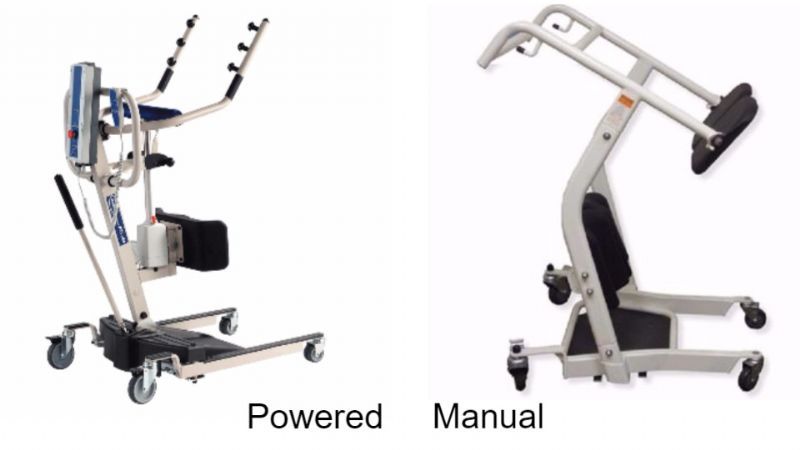 Written by Hulet Smith, OT
Written by Hulet Smith, OT
Standing lifts are specifically designed to secure patients during transfers from a seated position to a standing position, enabling quicker, easier, and safer patient lifting and transfer for both the patient and the caregiver.
Naturally, when purchasing any piece of medical equipment used for support or lifting, the device’s weight limitations should be the number-one consideration.
Each product has its own specific weight capacity, and most standing lifts bear a weight capacity within the range of 250 - 400 pounds.
However, some lifts are designed to support higher weights; these models are perfect for bariatric patients. Because the ability to support the patient’s weight is a critical factor to a standing lift’s safe use and effectiveness, it is highly recommended customers check this feature first!

As is the case with many other types of patient lifts, standing lifts are available in both powered and manual designs.
Powered standing lifts make use of a battery or wall outlet to lift the patient between a seated and standing position via the motor’s mechanical power.
Manual standing lifts, on the other hand, require the assistance of a caregiver to lift the patient to a standing position. Typically, manual standing lifts are less expensive and ideal for patients who are more stable, while powered lifts tend to cost more and are ideal for patients who require greater support while standing.
Each standing lift offers varying amounts of equipment to assist the patient and caregiver during the process of standing or sitting. This additional equipment can include specialized padded hand grips, lifting harnesses, and supporting straps for ankles and knees, among other things.
While these items are not a necessity for some patients, they can be extremely useful for others.
If you or your loved one requires additional support or comfort, these items are certainly worth considering with your standing lift purchase!
An oft-overlooked feature in a standing lift, the weight of the lift itself can be particularly noteworthy for customers who plan to use the lift for in-home care.
Heavier standing lifts, while an innate part of some lift designs, can also be a challenge for caregivers to move from room to room. For this reason, customers - particularly those who provide care in a one-on-one, in-home format - should consider the weight of a standing lift and their personal ability to maneuver that weight.
The majority of standing lifts offer customers additional features which may or may not be available from other products. These features cover a sizeable range of potentially significant areas for patient care.
Among many others, these features include specialized rubber gripping at the foot of the lift (helping patients maintain their footing), and locking mechanisms which allow the lift to attach to either a wheelchair or bed.
Because additional features can be a diverse category, we encourage customers to look through each product’s offerings in this category.
Given the aforementioned diversity of designs, capabilities, and features in standing lifts, it likely comes as no surprise that the selection of these products at Rehabmart is as assorted as it is large. The lifts are produced by trusted and reliable medical equipment manufacturers such as Invacare, Drive Medical, Romedic, Prime Engineering, Joerns, R82, Rifton, and Prism Medical.
Standing lifts (also known as sit-to-stand lifts) are an essential tool to reduce the risk of a fall when transferring a patient between a seated and standing position. These devices typically make use of a metallic, padding-coated frame and some combination of supports and grips to assist the patient while keeping them both safe and comfortable.
Standing lifts are available in one of two formats: manual, or powered.
Manual lifts, as the name implies, provide little to no mechanical assistance to the patient, and thus require more exertion on behalf of the caregiver to raise or lower a patient.
Powered lifts assist caregivers by providing mechanical support. Using electrically-powered motors, these lifts raise or lower patients with little exertion on the part of the caregiver. They are, however, more expensive than manual standing lifts.
Curious about how lift slings come into play? Standing lifts use a drastically different sling mechanism than slings seen on hoyer lifts. In fact, some standing lifts do not use a sling at all!
Those that do use a thinner, strap-like sling intended to keep the patient from falling back while moving (as opposed to supporting the patient’s complete weight).
Standing lifts can serve a pivotal role for any patient who is capable of bearing some of their own weight, but still requires assistance to stand up or sit down.
To use a lift, patients ought to have full control of their head and neck, and be able to bend both knees and ankles with limited assistance.
Standing lifts drastically reduce one of the most prevalent risks associated with patients moving independently: falling. By providing patients with a firm, comfortable device that assists them when sitting or standing, these lifts offer safety to patients and peace of mind to loved ones.
Designed to assist limited mobility patients, standing lifts also provide an increased degree of safety for caregivers.
By serving as a support during transfers, lifts significantly reduce the amount of physical exertion required by a caregiver. This is a tremendous advantage for individuals in this profession, as strain from lifting and moving patients is one of the most commonly reported injuries by caregivers.
The majority of lifts are covered under Medicare Part B, as they are considered durable medical equipment (DME). However, the lift will almost always need to be prescribed by a doctor in order to be covered. Given this, we encourage you to discuss standing lifts with your doctor to help determine if they are the right piece of medical equipment for your needs!
Private insurance policies typically vary a bit more in coverage. It is highly recommended you look into your policy’s specific coverage prior to making a purchase.
In particular, your policy’s coverage of durable medical equipment (DME) would likely provide the clearest answer.
Buying a standing lift is the first step towards providing you or your loved one with safety, comfort, and support when transferring between sitting and standing. Rehabmart is here to help you through every step of the process of finding your ideal lift—from researching products to ordering one to your doorstep!
Ready to choose?
Browse our online selection of high-quality standing lifts!
You can also learn more about other types of patient lifts in our articles The 5 Best Standing Lift and How to Choose the Best Hoyer Lift.

Co-founder/CEO of Rehabmart, Pediatric Occupational Therapist, husband, and father. Passionate about connecting special needs kids with superb nutrition, sensory integration, and complementary health strategies. Excited about Rehabmart's mission to become the premier online educational platform which empowers caregivers by spotlighting innovative devices and interventions to achieve optimal patient response and recovery.